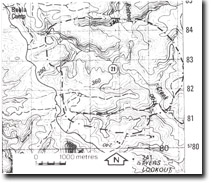21. Rintoul Creek
|
This information has been developed from the publications:
|
| Location: | 544835 to 562806. Rintoul Creek including the tributaries Paradise Creek and Exalt Creek. | |
Access: | Rintoul Creek Road. | |
Ownership: | Crown Land. | |
Geology/Geomorphology: | Exposures of Tyers Group Lower Cretaceous sediments occur along Rintoul Creek, paradise Creek, Exalt Creek and in several road cutting on the tracks between these. The sediments include conglomerates, sandstones, minor grits, mudstones, and a thin black coal seam. Well preserved plant fossils have been recorded from this sedimentary sequence. | |
Significance: | State. This is the best collected Cretaceous fossil flora area in Victoria. It contains some very good fossil plant localities and the fossils recorded are of great importance both in assessments of Cretaceous flora and environment and in determining stratigraphic relationships. | |
Management: | The most important fossil outcrops occur either in the creek channels or in low channel side bluffs and cliffs. Land use which would obscure these outcrops (e.g. flooding through reservoir construction) should be prohibited. Extension of roads and minor excavation on the interfluves would be compatible with the maintenance of the site as these may expose new fossil sites. | |
References: | Philip,G.M. 1962. The Jurassic sediments of the Tyers Group, gippsland, Victoria. Proc. R. Soc. Vict., 70, pp. 181-199. Douglas, J.G. 1969. The Mesozoic floras of Victoria, Parts 1 and 2. Mem. geol. surv., 28. | |



